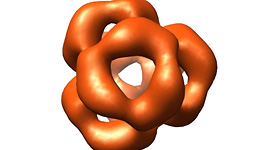Structure of protective protein in the eye lens explained:
Heat shock proteins provide protection against cataracts

Cells have a variety of protein complexes that manage vital tasks. The functions of these “molecular machines” depend largely on their three-dimensional structure. In the first instance, proteins are long chains of amino acids, like a long piece of woolen thread. So-called chaperones help them to fold in the desired three-dimensional form after their production. If this folding process fails, the protein thread becomes an inextricable, useless tangle.
Small heat shock proteins (sHsps) are a particularly important group of chaperones. They prevent the clumping of proteins under stress conditions. αB crystallin and the related sHsp αA crystallin are the main representatives of the sHsps found in humans. Whereas αA crystallin mainly occurs in the eye lens, αB crystallin is also very common in the brain and in the heart and muscle tissue. In the eye lens, they counteract diseases like cataracts. Malfunctions of the αB crystallin in tissue cells can give rise to cancer and neurological defects, including Alzheimer’s disease.
Many research groups have focused their work on the α crystallins due to their medical relevance. Despite intensive efforts, up to now, none of them have managed to determine the molecular architecture of these proteins. However, biochemists at the TUM have now succeeded in producing αA crystallins and αB crystallins recombinantly in bacteria and in obtaining uniform, clearly-structured complexes. A detailed structural analysis of these proteins was carried out in cooperation with the Chemistry Department’s Center of Electron Microscopy. The research groups were able to show for the first time here that, contrary to previous suppositions, αB crystallin forms a defined globular structure comprising 24 subunits, which are reminiscent of a perforated soccer ball.
Thanks to the identification of the three-dimensional structure of αB crystallin, which is currently being further refined, the basis has now been established for comparing healthy and disease-promoting mutants and, based on this, for clarifying the way they function. The scientists hope that this will lead to the discovery of new treatments.
This work was supported by the Deutsche Forschungsgemeinschaft (SFB594) (to J.B., M.H., and S.W.) and the Fonds der chemischen Industrie (J.B. and M.H.). J.P. acknowledges a scholarship from the Studienstiftung des deutschen Volkes.
Original publication:
The eye lens chaperone α-crystallin forms defined globular assemblies Jirka Peschek, Nathalie Braun, Titus M. Franzmann, Yannis Georgalis, Martin Haslbeck, Sevil Weinkauf, Johannes Buchner, PNAS, Early Edition, July 27, 2009, DOI: 10.1073/pnas.0902651106
Contact:
Prof. Dr. Johannes Buchner
Tel.: +49 89 289 13341
Fax: +49 89 289 13345
johannes.buchner@ch.tum.de
www.biotech.ch.tum.de/
Prof. Dr. Sevil Weinkauf
Tel.: +49 89 289 13517
Fax: +49 89 289 13521
sevil.weinkauf@ch.tum.de
www.ch.tum.de/em/
Technische Universität München
Department of Chemistry
Lichtenbergstrasse 4, D-85748 Garching